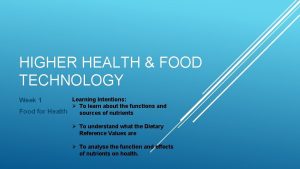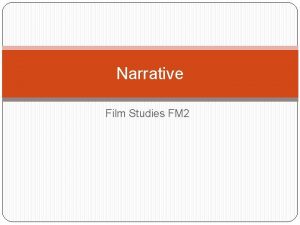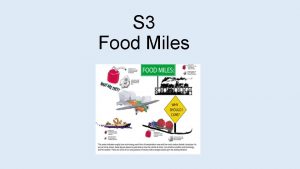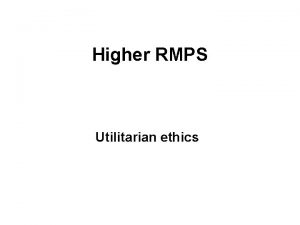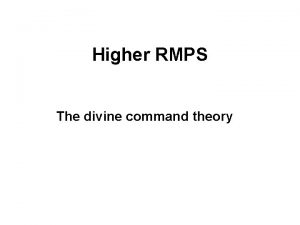HIGHER HEALTH FOOD TECHNOLOGY Learning Intentions To learn





















- Slides: 21

HIGHER HEALTH & FOOD TECHNOLOGY Learning Intentions: Ø To learn about the functions and Food for Health sources of nutrients Week 1 Ø To understand what the Dietary Reference Values are Ø To analyse the function and effects of nutrients on health.

COURSE OVERVIEW 3 units & Course Assignment Units: Food for Health, Food Product Development & Contemporary Food Issues Question Paper = 50% of marks Assignment = 50% of marks ALL units must be completed and unit assessments must be completed to achieve the whole course award. Units are a pass or fail basis with opportunity for re-assessment if necessary The course is graded A – D Assignments are sent off to SQA for external marking but will be initially checked and quality assured by HFT teachers. An initial check will be completed and will give you feedback on points to re -do or add to before final send off in May 2015. Questions?

PLAN FOR LESSON What you will be learning about in the Food for Health Unit Planning Protein, Hide for practical lessons of this unit Fats and Carbohydrates and Seek Questions

FOOD FOR HEALTH Analyse the relationships between health, food and nutrition Make and evaluate a food product to meet dietary and health needs. Nutrients: Protein, Fats, Carbohydrates, vitamins A, B group, C, D & E, Folic Acid, Calcium, Phosphorus, Iron and Sodium Fibre, Water & Energy Interrelationships between Nutrients Dietary related diseases: Obesity, CHD, HBP, Strokes, Type 2 Diabetes, Anaemia, Dental Caries, Osteoporosis, Osteomalacia& Diverticulitis. Dietary Reference Values Cooking methods Impact on health

28/08/14: Spaghetti Bolognaise – Casserole Dish & box 04/09/14: Apple & Cinnamon Scones - Box 08/09/14: Swiss Roll – Plate & box 18/09/14: Tuna Broccoli Bake – Casserole Dish & Box 29/09/14: Cream of Sweetcorn Soup – Flask or Plastic Box 08/10/14: Unit Assessment Practical – Depends on what you are cooking! PRACTICAL LESSON PLANNING

DIET, FOOD & NUTRITION A balanced diet is when a person eats a variety of foods and drinks that will provide them with the correct amount of nutrients their body needs Food is fuel to the body, we all need fuel however, it is important to have the correct amounts of the correct foods to ensure a balanced, healthy diet is maintained. Food provides the body with nutrients which are substances contained in foods that are essential to keep us alive and healthy and are grouped into macro and micro nutrients. Macro-nutrients are the main nutrients needed by the body in relatively large amounts. These are Protein, Fats and Carbohydrates. All nutrients have a function (job to do in the body) and sources food

The main functions of Protein in the body are: Growth and repair of body cells Maintenance of body cells. The secondary function of protein in the body is: To provide energy. Excess protein is stored in the body as fat. PROTEIN

There are two types of Protein: Animal (HBV) and Vegetable/Plant (LBV) Where a protein contains all the essential amino acids, they are known as High Biological Value (HBV) proteins. Mainly Animal Sources Where a protein lacks one or more of the essential amino acids they are known as Low Biological Value (LBV) proteins. Mainly Vegetable Sources High Biological Value (HBV) proteins are found in: Meat, Milk, Fish, Eggs & Cheese. HBV Protein is also found in Soya beans which are an essential source for vegetarians. Low Biological Value (LBV) proteins are found in: Cereals e. g. wheat, rice & oats. Pulses e. g. peas, beans and lentils, Some nuts. LBV protein is also found in gelatine (animal source) PROTEIN It is important to include a variety of LBV proteins in your diet to ensure you get all the essential amino acids, e. g. lentil soup with wholemeal bread, three bean chilli and rice. Complementary protein meals are a good way to incorporate both HBV and LBV proteins into your diet, e. g. Macaroni Cheese, beans on toast or spaghetti bolognaise.

Not Enough Too Much Growth in Children is slowed down Can be converted to fat in the body and Cuts and wounds will take longer to heal can lead to obesity if it is not used up as a secondary source of energy Protein deficiency is rare in the UK, however in poor countries it can lead to conditions such as slower growth, chronic infections that take longer or may not heal, poor quality hair and skin conditions. HBV proteins are the best source of Protein as they have all the essential amino acids and are mainly of animal origin. There a number of relatively new products which have been developed to supply HBV for Vegetarians these include Quorn, Tofu, soya milk and soya produce. PROTEIN AND ITS EFFECT ON HEALTH There are over 20 different amino acids. Adults require 8 amino acids and Children need 10. Animal sources provide all 10 essential amino acids however vegetable sources have 1 or more amino acids missing.

Why is protein needed in the body? What happens if too much protein is consumed? What are the two types of Protein? Name 3 sources of each type of Protein Explain the difference between the 2 types of protein? If not enough protein is consumed what can happen? Why is this not a common problem in the UK? Where can this be a problem? CHECK YOUR KNOWLEDGE

The main functions of Carbohydrate are: To supply the body with energy for all activities (including breathing & sleeping) To supply warmth and so help maintain normal body temperature (37ºC) CARBOHYDRATE

There are two types of Carbohydrates: Sugar and Starch(Total Complex Carbohydrate Sugar Starch – Total Complex Carbohydrates Sugar sources: Products containing refined sugar, e. g. cakes, biscuits, sweets, chocolate, jams & soft drinks Starch sources: Bread, flour, potatoes, pasta & rice. Sugars are divided into monosaccharides (e. g. sugar found in fruit) and disaccharides (e. g. refined sugar used in recipes, tea and coffee. ) Hidden sugars can be found in savoury products such as tomato ketchup! Many starch carbohydrate sources contain Nonstarch polysaccharide (NSP) or dietary fibre which isn’t a nutrient but essential to maintain good health. Mainly Wholemeal and wholegrains. CARBOHYDRATE Starch carbohydrates are better for us as they give a slow release of energy to the body, sugar carbohydrates give a quick burst of energy.

Not Enough Too Much A lack of energy leading to tiredness Can be converted to fat in the body and lead to obesity Protein can be used as a source for energy instead of growth and repair Too much sugar can lead to dental caries or diabetes. We are recommended to get most of our energy from Starch or TCC because: • Starches are good sources of other nutrients. E. g. potatoes are a good source of vitamin C and bread supplies protein, calcium and iron. • They bulk out our diet and make us feel fuller for longer. • They do not encourage dental caries Sugar is often referred to as “empty calories” it provides energy but no other nutritional value • Intrinsic sugars: these are naturally occurring sugars in food. E. g. Fruit and Vegetables (Fructose) • Extrinsic sugars: these are sugars added to foods. E. g. Refined sugar added to tea, coffee, extracted sugar from honey. They are known as Non -Milk extrinsic sugars (NMES) CARBOHYDRATE & ITS EFFECT ON HEALTH.

What are the functions of Carbohydrate? What does NSP, TCC and NMES stand for? Which is the better type of Carbohydrate to eat? Explain 2 reasons why? Explain the difference between intrinsic and extrinsic sugars What are the two groups of carbohydrates? Name 3 sources of each group of carbohydrate CHECK YOUR KNOWLEDGE

The main functions of fat in the body are: To provide warmth through an insulated layer under the skin To provide a concentrated source of energy To provide the fat – soluble vitamins A, D, E, & K To provide essential fatty acids To surround and protect the vital organs such as the kidneys FAT

Saturated Unsaturated A diet high in saturated fats tends to raise blood cholesterol levels, particularly low density lipoprotein (LDL) the “bad” cholesterol. This cholesterol tends to stick to the arteries, leading to blood clots and blockages of the artery. Mono and poly un-saturated fats help to lower LDL Cholesterol in the blood. They slightly increase the good high density lipoprotein (HDL) cholesterol. This cholesterol helps to ferry the cholesterol away from the arteries to the liver where it is broken down into bile. Sources are mainly animal origin: Meat and meat products, fats: butter, whole milk, cream & cheese FATS Sources are mainly vegetable origin: Olive oil, rapeseed oil, avocados, nuts and seeds, pure vegetable oils. Essential Fatty Acids Essential fatty acids EFA’s are necessary fats that humans cannot make, They must be obtained through the diet. The main EFA is Omega 3 – it helps to reduce the risk of blood clots, heart attacks and rheumatoid arthritis. Omega 3 is needed for brain development in babies and young children

Not Enough Too Much The intake of essential fatty acids such as Omega 3 may be reduced Can lead to obesity Fat soluble vitamins may be reduced Can lead to high blood pressure and coronary heart disease There are visible and invisible fats Visible fat is easy to see – fat on meat, and in butter, margarine, cooking oil. Invisible fat is a constituent part of the food and is difficult to detect – fat in cakes, biscuits and pastry. The term fat includes both fats and oils. Fats are solid at room temperature and are the saturated fats e. g. butter Oils are liquid at room temperature and are the unsaturated fats e. g. cooking oils FATS Beware of Transfatty acid Trans fatty acids, or hydrogenated fats as they are sometimes known are polyunsaturated fats which have been artificially hardened by adding extra hydrogen. These add an increased risk of heart disease, rheumatoid arthritis and are linked to some cancers. They are found in margarines, biscuits, commercially fried foods. Beware of foods that have hydrogenated fats on the label!

What are the two types of fat? Explain two functions of fat in the diet What does LDL and HDL cholesterol mean? And what is the difference between the two types of cholesterol? What are trans-fatty acids? Explain their effect on health What are essential fatty acids and why should we include them in our diet? CHECK YOUR KNOWLEDGE

http: //www. online-stopwatch. com/ Collect a worksheet Using the resources around the room you have 10 minutes to find out as much information about each nutrient start with Protein, when the buzzer sounds locate information about Carbohydrate then Fats. Write down what you find out on the worksheet HIDE AND SEEK

Divide into two teams Nominate one person to be a walker and another to be a scribe Scribes, collect a whiteboard, pen and duster Walkers are responsible for collecting question cards and bringing out the correct answer on the whiteboard. It is a competition between the two teams the fastest team wins! QUICK ON THE DRAW

In our next lesson we will be learning about Vitamins Exit task: Collect 3 strips of paper on one strip of paper write down what the function and sources of Protein, then on the second, the function and sources of Carbohydrate and then on the third, the function and sources of Fats. NEXT LESSON & EXIT TASK
 Understanding standards advanced higher geography
Understanding standards advanced higher geography Higher health and food technology
Higher health and food technology Poetry learning intentions
Poetry learning intentions How to write learning intentions
How to write learning intentions Learning intention examples
Learning intention examples Learning intentions and success criteria examples
Learning intentions and success criteria examples Persuasive writing images
Persuasive writing images Whole numbers chart
Whole numbers chart Basking shark poem analysis
Basking shark poem analysis Learning objectives of fractions
Learning objectives of fractions Half turn symmetry shapes
Half turn symmetry shapes Verbs for learning intentions
Verbs for learning intentions Poetry learning intentions
Poetry learning intentions Learning intentions and success criteria for mathematics
Learning intentions and success criteria for mathematics Poetry learning intentions
Poetry learning intentions Choices poem
Choices poem Creative writing learning intentions
Creative writing learning intentions Success acrostic poem
Success acrostic poem The crucible character map
The crucible character map The meaning of advent worksheet
The meaning of advent worksheet Shared clarity about learning intentions
Shared clarity about learning intentions Narrative learning intentions
Narrative learning intentions

